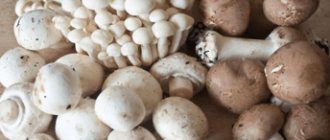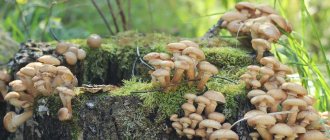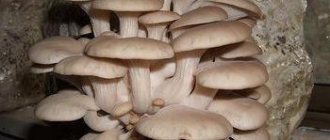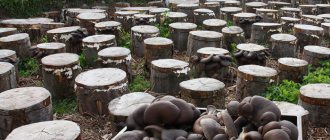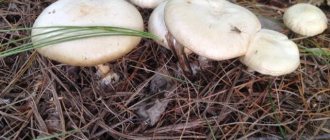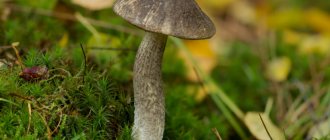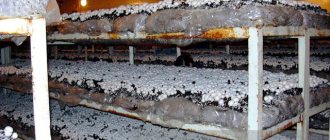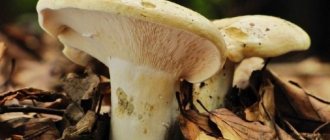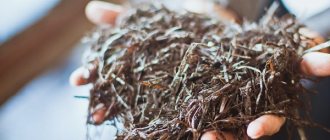Our site is located 300 meters from a busy highway.
To minimize damage from car fumes, Dad fenced the property with a line of trees. Among them there are fir trees, linden trees, birches and lots and lots of hazel. It turned out something like a forest in miniature. Last fall I found a small boletus under one of the birches. And, of course, I got excited about the idea of growing boletus mushrooms in the country. In the article you will find a detailed guide on how to plant this mushroom near your home, using different types of mycelium.
Where and how does boletus grow in nature?
The favorite places of the mushroom in natural conditions are the edges of ravines, sunny edges on the border of deciduous forests. Pleasant finds await the mushroom picker also in mixed forests, young aspen plantations and birch groves.
The collection of boletus begins at the end of May and lasts the entire season, until the first autumn frosts.
In nature, fungal spores spread with the direct participation of animals. When passing through the gastrointestinal tract of the animal, the boletus “seeds” lose their outer protective shell. Together with feces, they enter the soil, ready to germinate. If the place is suitable, the mycelium develops quickly on such natural fertilizer and the first fruiting bodies soon appear.
Harvesting
In order to stimulate the development of mycelium when growing boletus in the country, follow the basic rules:
- It is recommended to remove the fruiting body from the soil by loosening and twisting the stem. This is necessary so that its part, combined with the root, remains in the ground.
- After removing the boletus from the substrate, the resulting hole is sprinkled with country soil or a rotted leaf of a tree.
- When harvesting, only single fruiting bodies are twisted out. If boletus mushrooms accumulate in groups, pressing on each other, they are cut with a knife at an acute angle above the surface of the ground. The resulting stump is immediately sprinkled with garden soil.
After such collection, the myceliums are not damaged, but begin to recover. Then a new stage of the harvest is formed.
After collection, the fruiting bodies are inspected, impurities are removed, and a few millimeters of the stem are additionally cut off. Then the boletus mushrooms are soaked for 20 - 30 minutes. and begin further preparation.
Where to plant boletus mushrooms on the site
If parasitic mushrooms grow on the trunk of a garden tree, it means that it is weakened and is not suitable as a partner for the boletus mushroom.
The first and most important principle is that you need to choose the type of tree under which the mother mycelium grew .
In the case of purchased mycelium, any coniferous, deciduous and fruit crops are suitable. Of course, the best choice for boletus is birch.
Here are the basic requirements for a partner tree:
- Age . For our purpose, it is better to consider plants no younger than 4 years old.
- Good condition . The tree must be healthy, free from drying parts, growths and fruiting formations of tinder fungi.
- Sunny location . Carbohydrates are the main nutrient medium for mycelium. They are actively produced in the tissues of the tree, if only it is abundantly illuminated by the sun.
- The distance from the road is at least 3 meters.
- Convenient access to a water source . In dry summers, a mushroom plot will require frequent and abundant watering. Otherwise, the tree will absorb moisture and the mushrooms will not grow.
So, you have chosen a suitable companion for your boletus. Next, you need to decide at what distance from the tree to make holes for laying the mushroom substrate. It depends on the age of the plant:
- Young (5-10 years) - holes are made at a distance of 2-3 meters from the trunk.
- Mature (15-25 years) - at a distance of 4-6 meters.
- Old (over 50 years old) - at a distance of 6-8 meters.
Please note that these are average numbers. The main thing is that in the chosen place the roots of the tree are at a depth of more than 10 centimeters. After all, 10 centimeters is the minimum requirement for the depth of the holes. If placed more superficially, the mycelium will constantly dry out and will not take root.
Growing porcini mushrooms
We purchase porcini mushroom mycelium at any garden store - cultivation begins with this. Although you can not only buy planting material for sowing and growing mushrooms at home, you can also make it yourself. To plant and grow porcini mushrooms, you need to collect overripe, very old porcini mushrooms that have already begun to decay, and scatter them into small pieces. It will be full of spores - it’s the same as a prepared substrate, which will then bring you the same white mushroom.
— Is it possible to “sow” boletus in the same way?
- Whatever you scatter, that’s how it will be. But there are several subtleties here.
How to plant boletus mushrooms in the country: a detailed plan
Fresh birch sawdust can only be used in a mixture with leaves
The timing of planting a mushroom plantation generally coincides with the boletus collection season in the forest - from May to September. But still, the best time for this work is from mid-August to mid-September (in the middle zone).
At the end of summer, the daytime temperature still remains above +10 degrees, and frequent and heavy rainfall contributes to the rapid growth of the mycelium. Thus, when it gets cold, it is securely attached to the roots and overwinters successfully. But late sowing is often doomed to failure.
Step-by-step planting of boletus in a garden plot looks like this:
- Along the perimeter of the tree, holes are dug 20-30 centimeters deep and of the same diameter. If the roots lie too close to the surface, it is better to make a trench at least 10 centimeters deep, up to two meters wide and long.
- To destroy pathogenic bacteria and fungal competitors, it is advisable to sprinkle the bottom of the groove and pit with a fine fraction of oak bark. An alternative way is to pour strong tea leaves. To prepare it, take 100 grams of small leaves per liter of boiling water and leave for 10-15 minutes. Consumption per tree is 2-3 liters of tea.
- Birch sawdust, birch leaves, or a mixture of these materials are placed at the bottom of the recess. Layer thickness is 5-10 centimeters.
- Humus is poured on top, which is prepared in advance in places where boletus mushrooms grew. Instead of humus, it is permissible to use ordinary garden compost.
- The holes are lightly compacted and moderately moistened with rain or settled water (watering is not necessary if the substrate is contaminated with a solution).
- Grain mycelium or mycelium taken from the forest is evenly distributed on top. Or they water with a solution containing spores.
- This is followed by a layer of mulch from birch leaf shavings (3-5 centimeters) and, finally, garden soil with a layer of 3-5 centimeters.
- The last stage is to re-irrigate the mushroom plantation with rainwater so as to wet the ground within a radius of 1-2 meters from it.
- Plantings are mulched with stale sawdust, peat or hay in a layer of 20-30 centimeters.
By the way. Instead of a “layer cake” of sawdust and humus, you can use regular peat soil for vegetables or flowers.
Planting material
Before planting, it is important to calculate the correct amount of mycelium. It can be bought ready-made, but in just one sachet its quantity will be only 60 ml.
You can make boletus mycelium for growing mushrooms yourself. Without mycelium, boletus mycelium cannot appear, and spores (seeds) are used to prepare it. The following are used as a nutrient medium:
- Carrot agar. Consists of 600 ml water, 400 ml carrot extract and 15 g agar. Acidity is 6 pH.
- Oat agar. It contains 970 ml of water, 30 g of oatmeal and 15 g of agar. Before mixing, boil for about 1 hour and then filter using a special filter mesh.
- Wort agar. You need to use 1 liter of beer wort with Balling indicators of 7-8 degrees and agar in the amount of 20 g. Place the resulting mixture on the fire until it dissolves, and then pour the wort into separate containers, sterilize under pressure of 1.5 atmospheres. To grow mushrooms, you need to add mycelium with spores to the agar, which will serve as propagation material.
Method 5 - Oyster mushroom
Of all the mushrooms, the most not picky and does not require special care is oyster mushroom. Recently, many enterprises have appeared that breed, grow and sell planting material - grain sterile mycelium.
Oyster mushroom naturally grows on dead wood, preferring birch and poplar. For self-growing, you will need to prepare lumps of deciduous wood no more than 30 cm long and no less than 15 cm wide. Soak them in water for two days. In the prepared logs, drill holes at least 10 cm deep or make cuts with a saw. These holes are filled with moistened mycelium.
To ensure that the wood retains moisture, dig the base and cover it with moss, straw or sawdust, and cover with burlap. This method allows you to harvest within 2-4 years, until the logs completely rot.
Typically, mushrooms that you transplant from their natural habitat begin to bear fruit at the same time as their forest “brothers,” but under favorable conditions the harvest can be several times greater. Don’t be afraid to experiment, and also be patient, and you can create a real forest clearing on your site.
Contraindications
The boletus mushroom is the undoubted leader in nutritional and taste qualities, second only to the porcini mushroom. Eating this product will not cause any harm to a healthy adult, provided that the harvest was carried out in an ecologically clean area, well-known norms and rules, etc. were used during the preparation and procurement process. However, this product is considered difficult to digest due to the presence of chitin, which is a strong allergen.
There are several contraindications for use, namely:
- should not be eaten by children under three years of age due to the high protein content, which can disrupt the child’s enzymatic digestive system;
- people with individual intolerance and allergies;
- people with a history of chronic diseases of the gastrointestinal tract, for example, chronic pancreatitis, dysbacteriosis.
Growing boletus mushrooms on your own
If there are birch trees on the site that are older than four years old, then you can try to grow mushrooms under them on your own. A simple method will do for this. It consists of placing overripe mushroom caps under the trees, crushed and mixed with a small amount of gelatin and flour. During the summer, the ground near the birches is regularly watered with a watering can.
Perhaps next year the mycelium will grow and produce a harvest of fruiting bodies. If young mushrooms are collected in the forest, they can be broken, laid out under trees, covered with leaves, also regularly moistening the soil. Now it is possible to buy mycelium in a special store and place it under birch trees in accordance with the instructions.
Method 2 - Transfer the soil layer
One of the simplest ways to grow forest mushrooms (butterfly, saffron milk cap, boletus, boletus) is to transfer the top layer of soil, along with the sprouted mycelium, from the forest to a summer cottage:
- mark the place in the forest where the mushroom you like grows,
- at the end of the season, remove a layer of soil (about the size of a shovel) and transfer it to the site,
- the time between removing the soil and planting should be minimal to avoid drying out.
Important: make sure that inedible mushrooms do not grow nearby. Make sure the soil is not contaminated with their spores. The mushroom is more likely to take root under the same type of tree from which you took the soil.
Method 3 - Mushroom "seedlings"
This method is more complex, but brings better results, since the seeds (mycelium) of the fungus will be adapted to planting and have a sufficient food supply.
- select old, overgrown mushrooms,
- place them in a container or bucket,
- fill with rainwater or well water (do not use tap water),
- Place the container in a dark room with a constant temperature of approximately 20 degrees for several days. After a while, the mushrooms will spread into threads.
- add gelatin and wheat flour to the mixture, one tablespoon at a time, stirring with a wooden spoon or stick,
- Spray this solution on the areas in the area that you have designated for growing mushrooms.
In a year, the fungal spores will germinate, penetrate the root system of the tree, and after 2-3 years they will begin to bear fruit.
There is another option for awakening spores: after you chop the old mushrooms and add water, you need to add “French” (dry) yeast to this mixture at the rate of 2 teaspoons per 1 liter of mixture.
After a month, the mushroom pulp will settle to the bottom, and you can use the resulting liquid for sowing. Keep in mind that the solution is concentrated. For sowing, add 1 cup of solution per barrel of water.
After this, you can start sowing mushrooms: using a garden watering can, water the tree trunks of the trees under which the mushrooms will grow.
